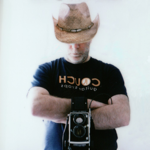
The First Experiment (the Whim)
The first experiment is nothing new. I was simply wondering what would happen if I loaded a roll of 35mm film in my Mamiya C220. I’ve shot 35mm in medium format cameras before, but those cameras all have a dedicated 35mm back. My Holga, Diana F+, and Belair Jetsetter all have their own 35mm backs. But my Mamiya C220 does not. So I bought some 35mm-to-120 film adapters and loaded the C220 with a roll of expired Orwo NP7 400.
Since the film gate on a medium format camera is much larger than a 35mm negative, the resulting photos fill the negative, sprockets and all, creating a cinematic widescreen panorama. What makes the Mamiya C220 different is that it is a 6×6 TLR and the film travels vertically. That means shooting 35mm film will give you tall vertical photos. If you want a regular horizontal panorama, you have to rotate the camera on its side. This makes taking photographs a challenge using the TLR’s waist-level finder. To make things easier, I attached the Mamiya’s porrofinder.[1]A porrofinder uses mirrors instead of a prism. While this makes it lighter, the image is still reversed left-to-right as it would be on a waist-level finder.

Using 35mm Film in the Mamiya C220
| Action | Winder Clicks | Equivalent Winder Turns |
| Loading Film | 70 | 2 |
| Advancing to Next Frame | 55 | 1.5 |
The second thing you should know is that unless the winder stops at the next frame, the C220 won’t let you cock the shutter. This is a fail-safe feature that prevents the user from accidentally taking multiple exposures. So to shoot 35mm, you just need to set the selector switch to multiple exposure.
The results speak for themselves. There is nothing really new here, except maybe that I think vertical panoramas are a great format for shooting whisky bottles (see photos below).

The Second Experiment (the Plan)
Now, I said these photos represent two experiments. The second experiment was the way I developed this roll of film. Orwo NP7 400 is the cinema version of Orwo NP27. I picked up a few rolls of this film a few years ago from Labeauratoire. At the time, I was still learning how to shoot film that had long been expired and I shot my first roll of NP7 at box speed.[2]I shot this roll at 100 ISO. The photos can be seen here. They were underexposed and grainy with a lot of base fog.
Then one day, while listening to the Homemade Camera Podcast, I heard an interview with Daniel Keating and he was talking about the success he had removing base fog using Benzo! If you’re not familiar with Benzo, it is short for benzotriazole, a well known anti-fogging agent that can be used when developing black & white film. You can buy it from Photographers’ Formulary and it comes in crystals. You simply mix 10 grams in 500ml of boiling hot water and stir until dissolved. This will make a 2% solution. Then, once it’s cooled, you add 30ml to a litre of your developer and process the film as you normally would.[3]Benzo can only be used with black & white developers, however some B&W developers, like Xtol, already include an anti-fogging agent. As far as I know, it isn’t necessary to add Benzo to Xtol.

I’m excited by the results. There’s grain, but the negatives are not as fogged as my first roll was. I have plenty of other fogged & expired film that I will repeat this experiment with. And I still have another roll of Orwo NP7. I think next time I may try adding Benzo as per Photographers’ Formulary when I develop it, just to compare the results. If you look closely at my photos (especially #2052), you will see surge marks which are the result of over-agitation. I’ll have to watch that the next time.

![]()
Footnotes




